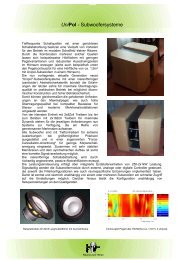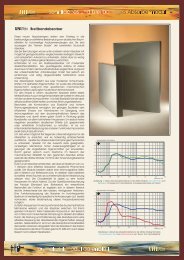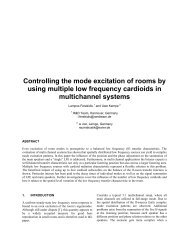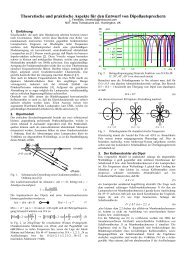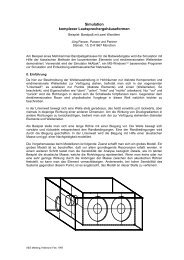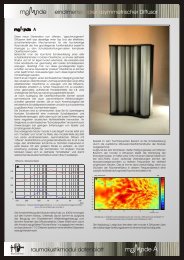the beneficial coupling of cardioid low frequency sources to ... - W Vier
the beneficial coupling of cardioid low frequency sources to ... - W Vier
the beneficial coupling of cardioid low frequency sources to ... - W Vier
You also want an ePaper? Increase the reach of your titles
YUMPU automatically turns print PDFs into web optimized ePapers that Google loves.
Proceedings <strong>of</strong> <strong>the</strong> Institute <strong>of</strong> Acoustics<br />
pattern. The subtle differences are mainly caused by different enclosure geometries. A high front-<strong>to</strong>back<br />
level ratio is only advantageous when <strong>the</strong> <strong>cardioid</strong> is directly placed in front <strong>of</strong> a wall. Here<br />
possible cancellation caused by <strong>the</strong> image source is efficiently suppressed.<br />
4.3 Practical considerations<br />
All <strong>the</strong> presented material gives support <strong>to</strong> <strong>the</strong> <strong>cardioid</strong> as <strong>the</strong> most versatile <strong>low</strong> <strong>frequency</strong> source<br />
(regarding mode excitation) <strong>of</strong> all <strong>the</strong> three <strong>sources</strong> examined. The investigation was concluded<br />
with a comparative measurement <strong>of</strong> a monopole, a dipole, and a <strong>cardioid</strong> LF-source in an ordinary<br />
listening room. To guarantee <strong>the</strong> comparability <strong>of</strong> <strong>the</strong> measurements all <strong>sources</strong> were placed at <strong>the</strong><br />
same position in <strong>the</strong> room. Orientation was chosen <strong>to</strong> give <strong>the</strong> smoo<strong>the</strong>st response for <strong>the</strong> dipole<br />
and was kept <strong>the</strong> same for <strong>the</strong> <strong>cardioid</strong>. The measurement be<strong>low</strong> confirms <strong>the</strong> previously found<br />
results. In particular, <strong>the</strong> monopole fails <strong>to</strong> excite any <strong>of</strong> <strong>the</strong> modes between 40Hz and 70Hz. This is<br />
a common problem <strong>of</strong> omnidirectional <strong>sources</strong> and is frequently observed. However, nei<strong>the</strong>r dipole<br />
nor <strong>cardioid</strong>, have any problem exciting <strong>the</strong> modes in this <strong>frequency</strong> range.<br />
Vol.25. Pt.8.2003<br />
dB<br />
0<br />
-10<br />
-20<br />
-30<br />
-40<br />
Level<br />
-50<br />
20 50 100<br />
Fig. 15 Transfer function <strong>of</strong> monopole (---), dipole (-.-), and <strong>cardioid</strong> (⎯) measured in ordinary listening room.<br />
5 Conclusions<br />
The conclusions <strong>of</strong> this study are summarised in <strong>the</strong> fol<strong>low</strong>ing.<br />
1) A <strong>cardioid</strong> <strong>low</strong>-<strong>frequency</strong> source unifies <strong>the</strong> physical properties <strong>of</strong> monopole and dipole.<br />
The front-<strong>to</strong>-back level ratio can be used as a measure for <strong>the</strong> level balance between two<br />
generic <strong>sources</strong> (monopole and dipole).<br />
2) A <strong>cardioid</strong>’s reduced rear radiation makes it insensitive <strong>to</strong> rear boundaries. A front-<strong>to</strong>-rear<br />
level ratio <strong>of</strong> 10dB is sufficient <strong>to</strong> secure this advantageous property.<br />
3) A <strong>cardioid</strong> excites room modes in pressure-nodes as well as velocity-nodes. Therefore its<br />
<strong>coupling</strong> <strong>to</strong> room modes is far less position dependent than that <strong>of</strong> a monopole or a dipole.<br />
Experiments prove that <strong>the</strong> <strong>cardioid</strong> maintains nearly <strong>the</strong> same mode excitation pattern<br />
even when placed in contrary positions (corner vs. centre). Turning <strong>the</strong> <strong>cardioid</strong> can help <strong>to</strong><br />
adjust for an even mode excitation pattern.<br />
4) Utilising a f<strong>low</strong>-resistance terminated enclosure enables a commercially viable design <strong>of</strong> a<br />
<strong>low</strong>-<strong>frequency</strong> <strong>cardioid</strong>. Front-<strong>to</strong>-back level ratios between 10dB and 20dB are feasible.<br />
Finally, <strong>the</strong> author thanks his colleague Uwe Kempe for building and assessing numerous<br />
pro<strong>to</strong>types and his patience when suffering controversial telephone discussions.<br />
Hz



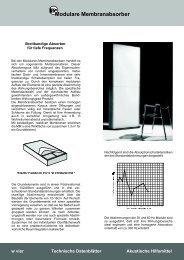

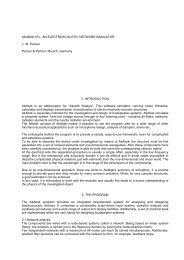
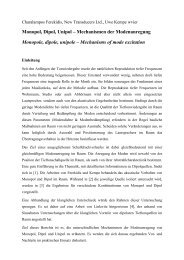
![Uwe KEMPE / Charalampos FEREKIDIS [w vier] Praktische ...](https://img.yumpu.com/16428023/1/184x260/uwe-kempe-charalampos-ferekidis-w-vier-praktische-.jpg?quality=85)

